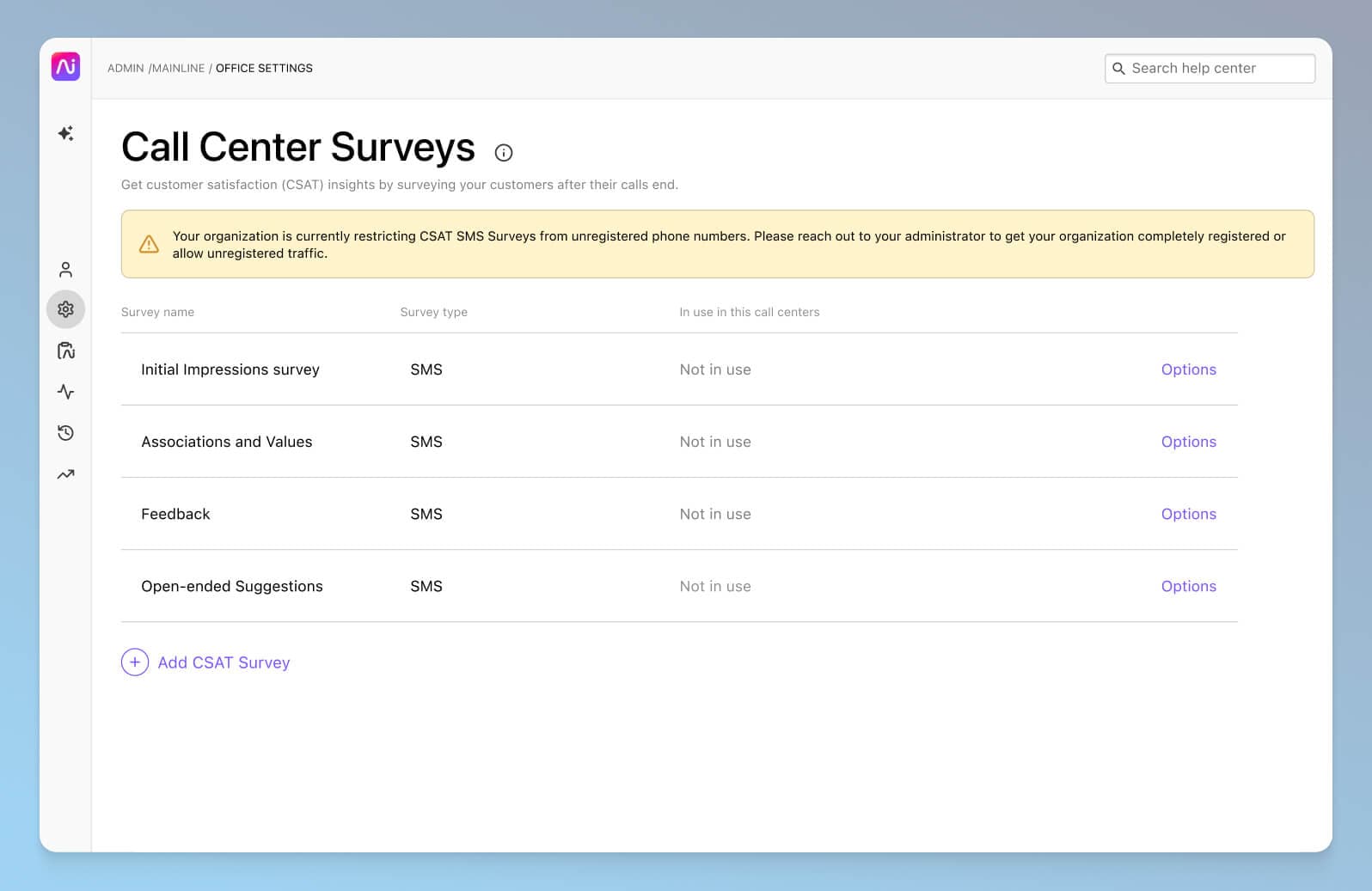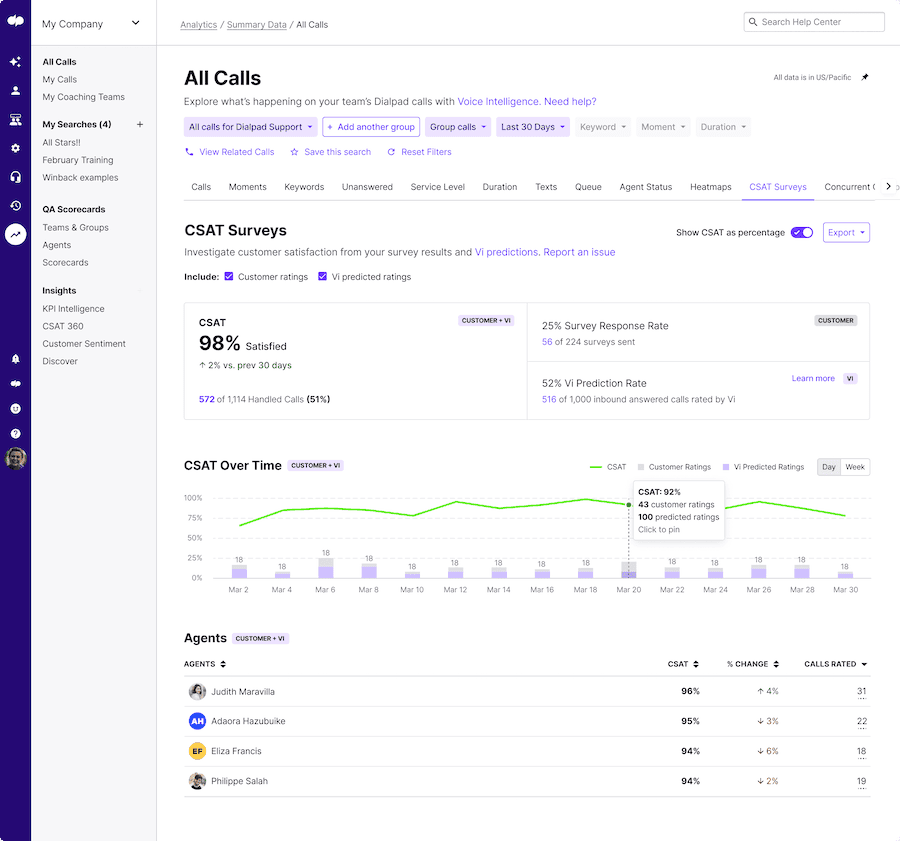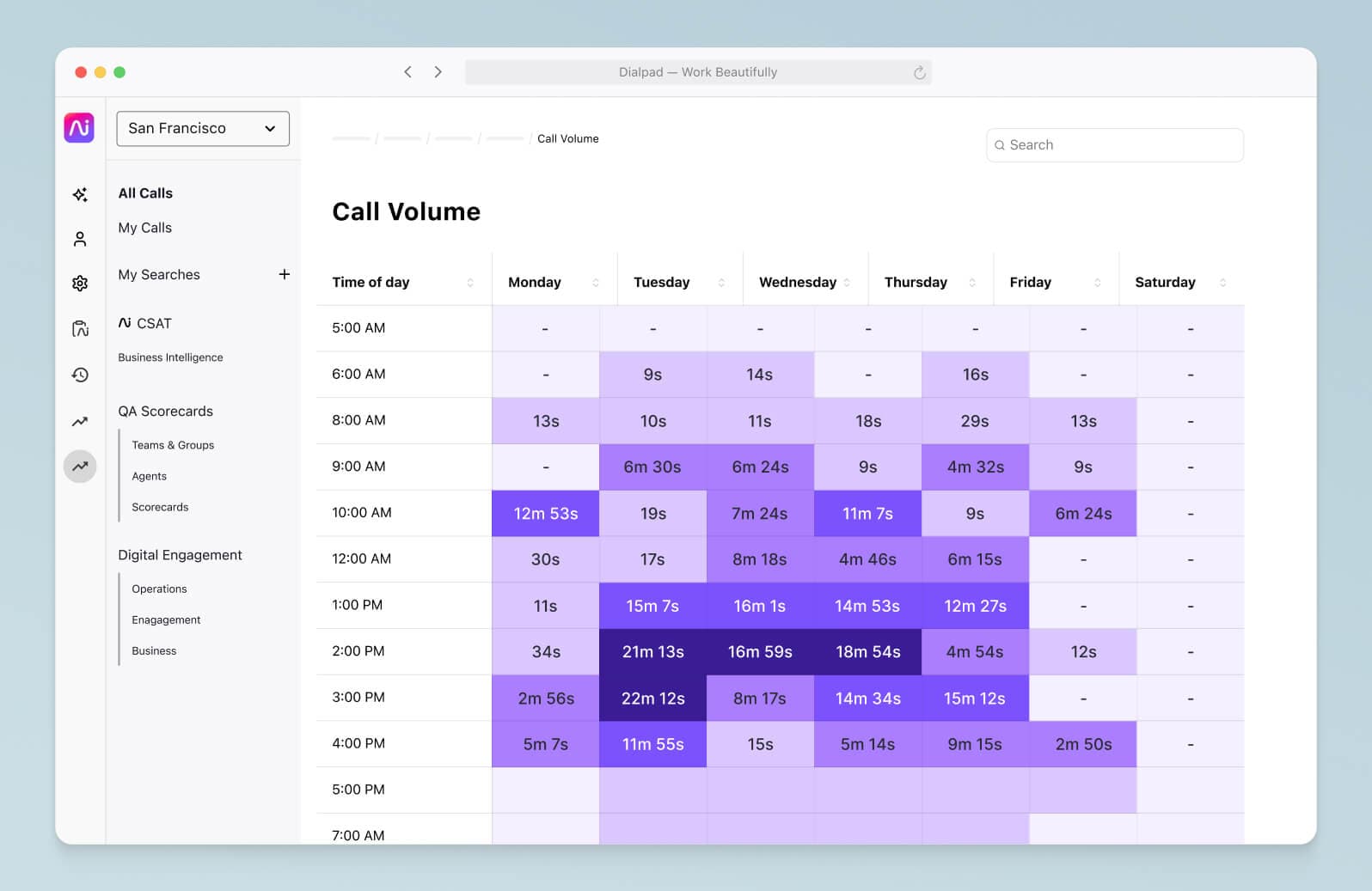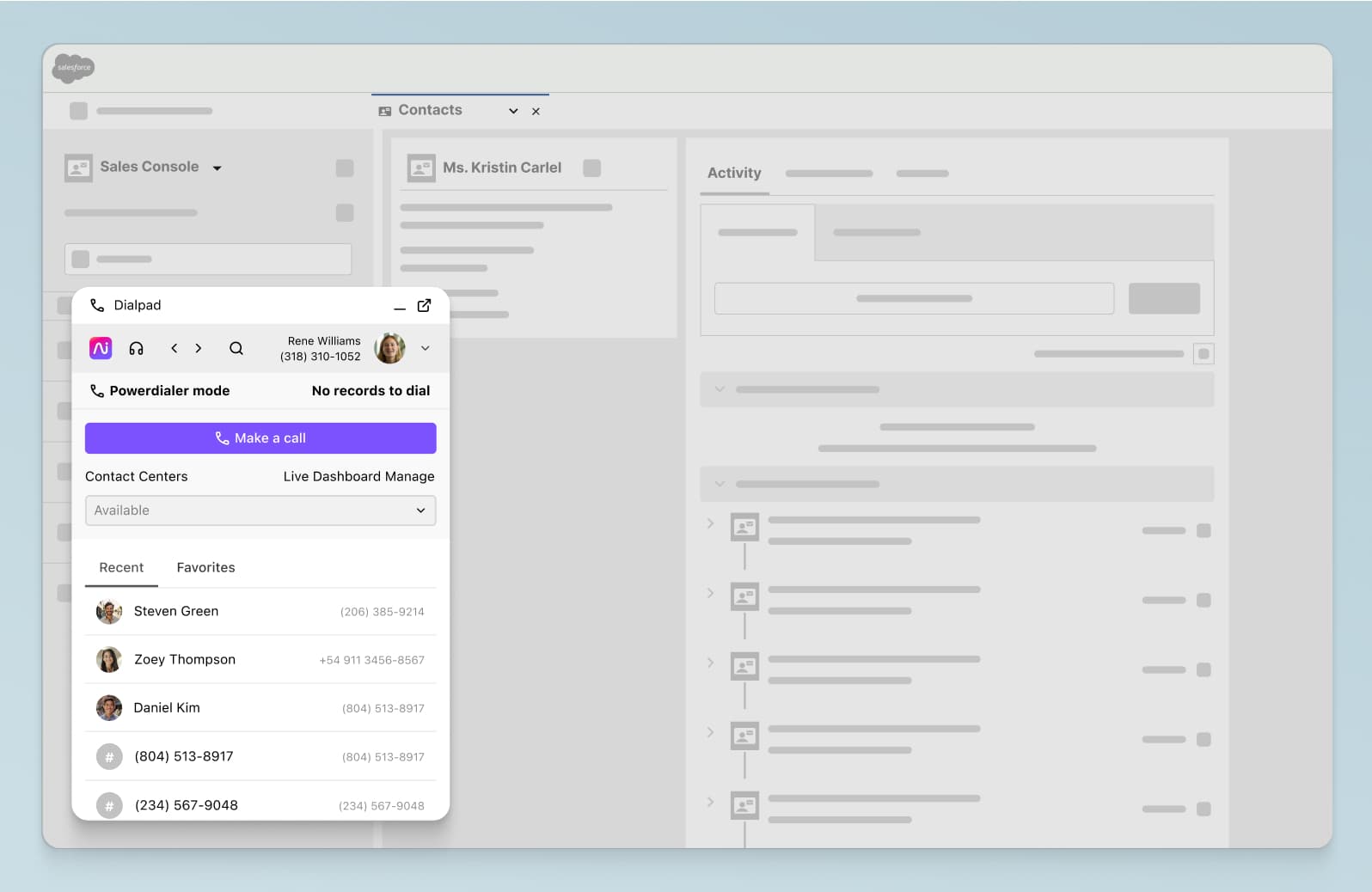a guide
Customer satisfaction factors
Learn about the key factors that influence customer satisfaction, and how you can keep your customers and prospects happy. Or, if you're looking for a contact center solution that can help with this, get a demo of Dialpad's AI-powered customer engagement platform!

Consumer satisfaction, or customer satisfaction, is one of the most important metrics to track for businesses in pretty much every industry.
It directly influences other antecedents like customer loyalty, new customer acquisition, and of course, your bottom line. But here’s the thing. Customer satisfaction doesn’t always look the same, and depending on your industry, you may not even be using the same metrics to measure it.
Below, we’re going to break down how to think about customer satisfaction by looking at three antecedents or key factors that affect customer satisfaction, as well as examining customer satisfaction through the lens of three major industries as examples. Through these examples, you should be able to apply those insights to think about what factors might affect customer satisfaction in your specific industry—and how you might help your contact center and agents improve their performance.
How to measure customer satisfaction
Typically, to measure your customer satisfaction or CSAT scores, you’d send a customer satisfaction survey or questionnaire to your customers after a certain interaction (like a live chat or support call).
Respondents can then rate you on a scale of one to five, which you can use to calculate your CSAT score. In Dialpad’s contact center platform, for instance, you can set up a CSAT survey with a few clicks:

If you’re concerned that not enough customers are filling out the survey, Dialpad has an artificial intelligence-powered feature that can help with that too.
It’s not an uncommon problem—depending on the industry and specific business, we've found that on average only about 5% of customers actually fill out CSAT surveys. On a related note, usually only the angriest (and happiest) customers actually bother to respond to these surveys, which means your CSAT answers are likely to be very skewed and not representative of how your customers feel overall.
Dialpad's industry-first Ai CSAT feature is designed to solve exactly that. Not only can our Ai transcribe calls and analyze sentiment in real time, it can also infer CSAT scores for 100% of your customer calls thanks to its hyper-accurate transcription feature. The result? A much more representative sample size for CSAT scores, and a more accurate understanding of how satisfied your customers really are:

2 important factors of customer satisfaction
If you really break it down, there are two main elements that can boost—or tank—your customer satisfaction scores. You’ll notice that I’ve framed both of these using customer perception, meaning we’re not just talking about your product quality; we’re talking about your customers’ perception of your product quality.
Why? To know how your customers perceive you, you must know how to measure customer satisfaction. You might have a super solid product by your own standards, but if it doesn’t do what your customers want—then they’re not going to perceive that value, and by extension, experience low customer satisfaction. It’s all about perceptions here.
Okay. Now let’s look at each of these and how you might (or might not) be able to influence each one.
The perceived value of your product or service
This customer satisfaction factor refers to the standard that your customers feel your products or services are reaching. Do they feel like they got what they paid for, or is the quality lower than what they were expecting?
As a customer support team, unfortunately the product quality is something you don’t really have control over. You can help the customer as best you can when issues come up, but if they bought a poorly made product that causes low customer satisfaction, there’s not a whole lot you can do by that point to fix that customer expectation gap.
The perceived value of your customer service
When discussing factors influencing customer satisfaction, the other huge factor is, of course, great customer service (or really terrible customer service).
For a customer support team, service quality is something that’s within your control. But the idea of “customer service” is still pretty nebulous and broad—let’s break it down further into more manageable pieces and how you can tackle each one.
Response times
Your customers want to be helped in a timely manner when they reach out for help. There’s no better way to create loyal customers than by helping your existing customers solve their problems as quickly as possible.
To ensure that your hold times are kept to a minimum, make sure to staff your contact center appropriately and keep an eye on metrics like average handle time, abandoned calls, and average speed to answer.
Dialpad’s customer engagement platform, for example, comes with built-in analytics that display these metrics in intuitively designed dashboards and heat maps:

If you could be sure that your questions or issues always got resolved quickly and painlessly every time you tried to contact a certain company, how would that impact the perceived value of that product or service? Would it even offset any dissatisfactions you had with that product? (For some people, this is probably a yes!)
Personalization and customer preferences
This is especially relevant for ecommerce businesses and the world of online shopping, but personalization can play a huge role in customer satisfaction. (Has a company ever recommended products for you based on your past purchases? That’s personalization at work!)
Even if your business doesn’t involve online shopping, you can still personalize your service by connecting your CRM (Customer Relationship Management) platform with your contact center software.
This way, your support agents can quickly get a history of a customers’ needs, past purchases, and preferences right in their profile in the CRM. For example, Dialpad integrate with CRMs like Salesforce and HubSpot to automatically log activities and call notes:

Not only does this help you win potential customers and nudge them toward a purchase decision (or repurchase), it also makes your customers feel as if they’re not just a number—that you remember who they are—which tends to lead to a higher level of satisfaction.
Availability
Finally, customers today are reaching out to businesses using a wide range of communication channels. They aren’t just calling you anymore—many consumers are tagging businesses with questions on public social media posts (also a great place to poll your audience and do market research), chatting with your agents (or support chatbot) on your website, and even texting you.
If a customer has been DMing you on Twitter for days with no response because you’re busy providing amazing support on the phone, they’re still going to perceive a low level of service quality because you weren’t able to meet them on the channel they prefer.
Every service provider is different, of course, and in some industries, people may not try to reach a business through social media at all—you have to find out what yours prefer. If you do discover that you’ll need to support different support channels, then you’ll need a contact center platform with omnichannel functionality that lets your agents handle all these different conversations in one convenient place. For example, Dialpad is designed for voice calls, video calls, SMS messaging, live chat, and more—all in one intuitive app:

Understanding the biggest impacts on customer satisfaction in 3 major industries
Factors influencing customer satisfaction don’t exist in isolation—we’ll look at three industries as examples below and how organizations can build customer trust by providing a good experience throughout the buyer journey.
Retail
Another industry where companies have a huge incentive to keep customers happy is retail.
What is tricky here, though, is that customer satisfaction is driven by both the perceived value of the product, and also customer service quality.
Online customer experience
To improve the customer experience in retail and ecommerce, a smooth journey with lots of self-service is essential.
A lot of this functionality will have to be built into your website. Can a customer make a purchase online? Can they contact you about refunds or exchanges easily, or is that a painful process because they have no way of talking to a human?
In general, a good customer experience here will have a blend of self-service automations and human agents to support the more complicated questions.
Product quality
Again, this element is out of your control as a customer support or contact center team, but product quality is going to be a huge determinant and predictor of customer satisfaction. If your customers receive your product and believe that it’s worth what they paid for it, it can make up for other shortcomings in your service quality—but don’t rely on this. Think of it more as a buffer.
Personalization
With retail and online shopping specifically, personalization is one of your most important tools because it can influence not only service quality, but also repurchases and additional sales.
If you can tailor your recommendations and incentives to existing customers based on what you know about their preferences, that can be a key determinant of customer satisfaction and also makes it more likely that you’ll recommend the right products to them.
Healthcare
Now, let’s pivot to healthcare, which has a very different concept of what “satisfied customers” means. In this case, it would be patients who are concerned with the healthcare (or the “product” here) that they’re receiving from a physician or specialist.
The factors affecting customer satisfaction, so to speak, would include these:
General communication
For healthcare patients, it must be easy to get in touch with specialists and to continue with follow-ups or check-ups after initial appointments. Unlike purchasing a product, in healthcare, the service quality is a huge part of the “product.”
With Dialpad, for instance, healthcare providers can maintain HIPAA compliance while handling patient communications and providing a good experience.
📚 Further reading:
See how Proliance Surgeons and Fenway Health use Dialpad to provide a good experience for their patients, while giving agents the flexibility to work from anywhere.
Accessibility to physicians and staff
To maintain strong patient relationships, it helps if they’re able to actually reach their therapist or physician relatively easily. For example, Kathy Smith, the Practice Manager at Metropolitan Pediatrics, works remotely from time to time, but can still communicate with patients easily.
“Dialpad is easy to use, and if I happen to be working remotely, I can still access it and call patients. I can call from my cell phone and they’ll think I’m at the office because it all comes from Metropolitan Pediatrics,” she says.
“I can call an extension if I need to get anyone at the office. So those things have saved a lot of time.”
Banking and finance
When it comes to customer service in financial services, service quality is important, but so is security. This is a bit of a unique case in that the perceived value of the services are impacted even more heavily than usual due to the sensitivity of the information being shared. One security breach could seriously impact customer retention.
Omnichannel experience
The omnichannel experience has a significant impact in the banking industry because even though banks historically have communicated with customers over the phone and in-person, the long wait times and back-and-forth inconvenience have largely given way to more immediate responses through digital and self-service channels. Not only does this help improve customer satisfaction, it also reduces the burden on agents.
Speed of service
On a related note, regardless of demographic, customers also expect quick resolutions, especially when it involves lost or stolen credit cards and certain financial transactions. To address this, more and more financial institutions are using self-service options on their website and even through mobile apps to let customers quickly report a card lost, apply to open a new account, and invest in products—without a lot of the hassle that historically has accompanied these tasks.
Ready to improve customer satisfaction?
From spreading positive word of mouth to purchasing again from you in the future, happy customers can help businesses and organizations in a huge variety of ways.
The three main customer satisfaction factors that we’ve discussed earlier are all important considerations, no matter what industry you’re in, if you want to have strong customer relationships and improve their lifetime value.
With functionality like AI-powered agent assist cards, live call center transcription, a huge selection of integrations, and more, Dialpad gives you a robust solution for omnichannel customer service. See how it works now!
Improve your customer satisfaction with Dialpad
See how Dialpad is designed to help customer support teams keep customers happy—proactively. Book a demo, or take a self-guided interactive tour of the app on your own!
